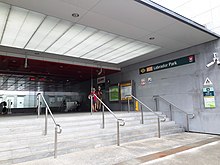|
Labrador Park
CC27 拉柏多公园 லாப்ரடார் பூங்கா | |||||||||||
|---|---|---|---|---|---|---|---|---|---|---|---|
| Mass Rapid Transit (MRT) station | |||||||||||
 Platform level of Labrador Park MRT station with the artwork in the background. Platform level of Labrador Park MRT station with the artwork in the background. | |||||||||||
| General information | |||||||||||
| Location | 701 Telok Blangah Road Singapore 109029 | ||||||||||
| Coordinates | 1°16′20″N 103°48′10″E / 1.272267°N 103.802908°E / 1.272267; 103.802908 | ||||||||||
| Operated by | SMRT Trains Ltd (SMRT Corporation) | ||||||||||
| Line(s) | Circle Line | ||||||||||
| Platforms | 2 (1 island platform) | ||||||||||
| Tracks | 2 | ||||||||||
| Connections | Bus, Taxi | ||||||||||
| Construction | |||||||||||
| Structure type | Underground | ||||||||||
| Platform levels | 1 | ||||||||||
| Parking | Yes (PSA Building) | ||||||||||
| Bicycle facilities | Yes | ||||||||||
| Accessible | Yes | ||||||||||
| History | |||||||||||
| Opened | 8 October 2011; 13 years ago (2011-10-08) | ||||||||||
| Electrified | Yes | ||||||||||
| Previous names | Alexandra, Tanjong Berlayar | ||||||||||
| Passengers | |||||||||||
| June 2024 | 5,818 per day | ||||||||||
| Services | |||||||||||
| |||||||||||
| |||||||||||
Labrador Park MRT station is an underground Mass Rapid Transit (MRT) station on the Circle line, located within Bukit Merah planning area, Singapore.
Built underneath Telok Blangah Road near the junctions of Alexandra Road and Labrador Villa Road, this station was named after the nearby Labrador Nature Reserve. It is the nearest MRT station to the PSA Building and Gillman Barracks, the latter of which is now home to numerous art galleries.
Etymology


This station is named after Labrador Park, a historical site which held former fortifications and naval guns built by the British forces in Singapore before World War II. Another name is also Tanjong Berlayer. It is the name given to the craggy granite outcrop that formerly stood in the gateway of Keppel Harbour in Singapore. The rocky outcrop served as navigational aids to ancient mariners sailing through the swift waters of the narrow channel between them, but was subsequently destroyed by the British in 1848 to widen the channel for larger vessels to sail through. In 2005, a symbolic replica was erected by the Singapore government near its original site to mark the role in the history. It was also called Batu Berlayar in Malay, Dragon's Teeth Gate in English and Long Ya Men in Chinese.
Art in Transit
The artwork featured in this station under the Art in Transit programme is Without Which/Would Have Been/Impossible by Heman Chong. The art piece, located on the side of the lift shaft in the station, consists of the title of the piece and several coloured circles of different sizes arranged in a regular fashion. According to the artist, the motif came from a "microscopic view of a single rock" found at Labrador Park, highlighting the park's distinctive identity as the last surviving rocky sea cliff in Singapore.
References
- "FINALISED NAMES FOR CIRCLE LINE (CCL) STAGES 4&5 STATIONS". www.lta.gov.sg. Archived from the original on 18 December 2006.
- "Station Names For Circle Line Stages 4 And 5". www.lta.gov.sg. 7 November 2005. Archived from the original on 23 Apr 2010.
- "Land Transport DataMall". Datamall. Land Transport Authority. Archived from the original on 14 August 2024. Retrieved 14 August 2024.
- Martin, Mayo. "Circle Line Art! The final destination(s)! A sneak peek!". For Art's Sake!. TODAYonline Blogs. Archived from the original on 27 December 2011. Retrieved 12 October 2011.
External links
 Media related to Labrador Park MRT Station at Wikimedia Commons
Media related to Labrador Park MRT Station at Wikimedia Commons- Official website
| Italicised locations are currently not in operation | |||||
| Circle Line |
| ||||
| Depot(s) | |||||
This Singapore MRT-related article is a stub. You can help Misplaced Pages by expanding it. |
